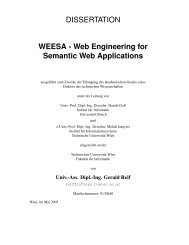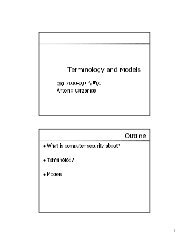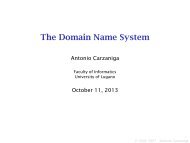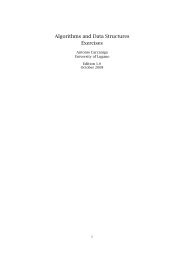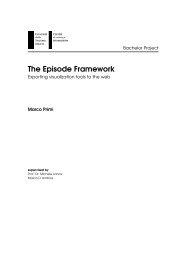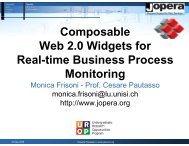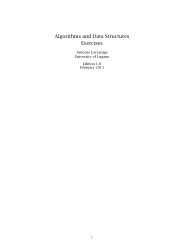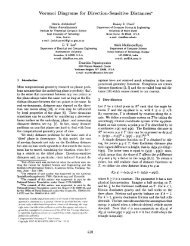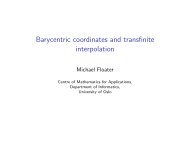Extractive Summarization of Development Emails
Extractive Summarization of Development Emails
Extractive Summarization of Development Emails
Create successful ePaper yourself
Turn your PDF publications into a flip-book with our unique Google optimized e-Paper software.
2. Is extracting only keywords more schematic and easy to understand than selecting entire sentences, or<br />
is it the contrary?<br />
3. Should we propose both extraction methods?<br />
To give us answers, we performed a pilot test with one person (participant A):<br />
• 6 email threads chosen from ArgoUML 10 mailing list are the material for the test.<br />
• Participant A must sum 3 <strong>of</strong> these by extracting keywords and the other 3 by extracting sentences.<br />
• We annotate the outputs with the type <strong>of</strong> included email messages, the length <strong>of</strong> the thread measured in pages,<br />
the time used to summarize the thread, and the keywords or sentences extracted.<br />
The material is in Appendix A.1.<br />
Here we report the considerations <strong>of</strong> participant A immediately after the test:<br />
• Extraction <strong>of</strong> sentences is easier and more natural than extraction <strong>of</strong> keywords.<br />
• Keyword extraction takes almost twice the time.<br />
• In keyword extraction, digrams, trigrams 11 and very small noun phrases <strong>of</strong>ten must be selected as a single<br />
keyword.<br />
• If a person does not know the system, understanding which method signature or variable or constant should<br />
be considered is hard, because everything seems to have the same importance.<br />
• With sentence extraction applied to pieces <strong>of</strong> source code, only comments are considered.<br />
• By extracting keywords, there is a high risk <strong>of</strong> missing relations among them.<br />
• Usually chosen sentences are subsets <strong>of</strong> the chosen keywords, because with the keyword extraction a person<br />
is tempted to underline also many concepts that are not so important for the general comprehension <strong>of</strong> the<br />
email.<br />
Some considerations seem counterintuitive. For example, the fact that the participant took more time for keyword<br />
extraction than for sentence extraction, and the fact that extracted sentences are a subset <strong>of</strong> the sentences<br />
containing keywords. Other remarks that we want to investigate more deeply are the unavoidable need to extract<br />
digrams and trigrams instead <strong>of</strong> single terms.<br />
We decided to carry out a second pilot test with another person (participant B) just to confirm (or to put even<br />
more into question) our supposition. The test material and the assignment are the same; the test output can be<br />
found in Appendix A.2.<br />
We propose to participant B a questionnaire:<br />
a) Is it easier to extract main keywords or sentences from the emails? “Keywords."<br />
b) Is it faster to extract main keywords or sentences from the emails? “Keywords."<br />
c) During keyword summarization, did you sometimes feel the need <strong>of</strong> underline digrams/trigrams?<br />
“Yes, especially in natural language when there are negations."<br />
d) Since you already know what the system the emails are talking about does, did you find difficult to understand<br />
the real meaning <strong>of</strong> the emails?<br />
“No, just in extreme cases like when they talk about the tools used in the implementation."<br />
e) When you extract sentences from the emails containing code/script/compilation report, did you underline<br />
pretty much just the comments or also many parts <strong>of</strong> the code itself?<br />
“No, I also considered classes and methods name."<br />
f) Did you feel in keyword summarization that some logical link among subordinates went lost?<br />
“Yes, especially when to a sentence with positive sense a phrase with negative sense follows (or viceversa)."<br />
10 http://argouml.tigris.org/<br />
11 An n-gram is a contiguous sequence <strong>of</strong> n words belonging to the same sentence. So a digram is formed by two words, a trigram by three<br />
words.<br />
12



